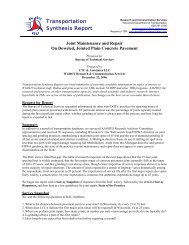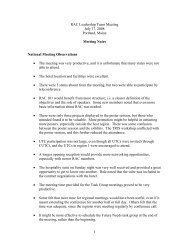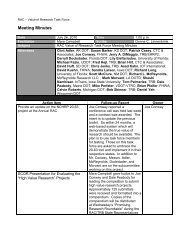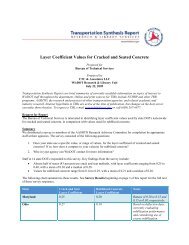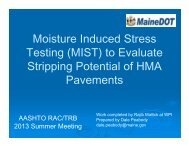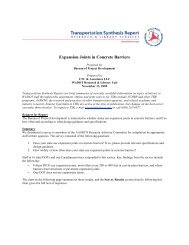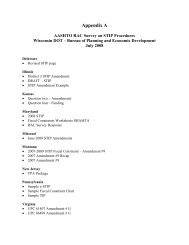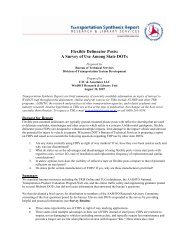PART IV: Summary of Comments - SCOR/RAC
PART IV: Summary of Comments - SCOR/RAC
PART IV: Summary of Comments - SCOR/RAC
You also want an ePaper? Increase the reach of your titles
YUMPU automatically turns print PDFs into web optimized ePapers that Google loves.
<strong>PART</strong> <strong>IV</strong>: <strong>Summary</strong> <strong>of</strong> <strong>Comments</strong>17-May-10Reviewer <strong>Comments</strong> Distribution <strong>of</strong> Ratings■ [Rating: 5] This project supports the International Scan program and State representation in PIARC, allowing FHWA t<strong>of</strong>ulfill standing international commitments and obtain foreign information to improve US highway system. Projectsupplements FHWA funds to ensure viability <strong>of</strong> international outreach based on shared priorities.Research Advisory Committee■ Can this data be shared in other ways - especially with the volume <strong>of</strong> information now available in various medias.Item #8:D-11Performance-Based Specification for Binders Used inChip Seals (and other SurfaceTreatments)(17)(46)NR 0 1 2 3 4 5<strong>SCOR</strong> 2 7 8<strong>RAC</strong> 1 2 2 7 17 20Standing Committee on Research■ Currently we have no performance-based specification for emulsions and binders used in surface treatments. Movingtowards a common performance-based spec system for these binders and emulsions will provide greater uniformity andshould improve the material quality, and thus increase the performance. Surface treatments are widely used in bothmaintenance and preservation, and so improvements in performance will have widespread pay<strong>of</strong>f.■ Research to include rubberized chip seals.■ California has implemented the binder performance specs in select types <strong>of</strong> chip seal applications. California would verymuch like to implement binder performance specs (including emulsions) in all surface treatments.■ High potential.■ This is a major need for DOT across the country as we implement pavement preservation programs. The likelihood <strong>of</strong>success is high. A performance specification will help all agencies ensure successful chip seal projects.■ Emulsified asphalts are still being specified based on outdated criteria (i.e., penetration, viscosity, etc.) Would be good tomove to PG system for these materials. Also, ADOT is using more chip seals due to budget constraints. Other states arelikely doing the same.■ [Rating: 4] The subject problem statement is timely and clearly articulates the shortcomings <strong>of</strong> the current Superpavebinder specification in addressing its application to chip seals and other surface treatments.Research Advisory Committee■ Yes. This could have some merit.■ Better chip seal binder performance may increase use, but local freeze/thaw and plowing would likely limit chip seals inwet freeze/thaw environments■ Do not suggest combining with NCHRP 10-82,■ Subcommittee on Materials rated this a HIGH priority item. As more emphasis is placed on preventative maintenancethere is a real need to advance the testing to catch up with the technology. I strongly recommend endorsement <strong>of</strong> thisproposal.Other■ [Rating: 2]■ [Rating: 5] The proposed research aims at developing performance-based specifications for binders used in chip seals andother surface treatments.- NCHRP Project 14-17, scheduled for completion in early 2010, will develop a manual for emulsion-based chip seals forpavement preservation that may address some related issues.- An upcoming NCHRP Project 10-82, Performance Related Specification for Pavement preservation Treatments, willdeal with some surface treatments but may not develop performance-related specifications for binders.<strong>IV</strong>-3



